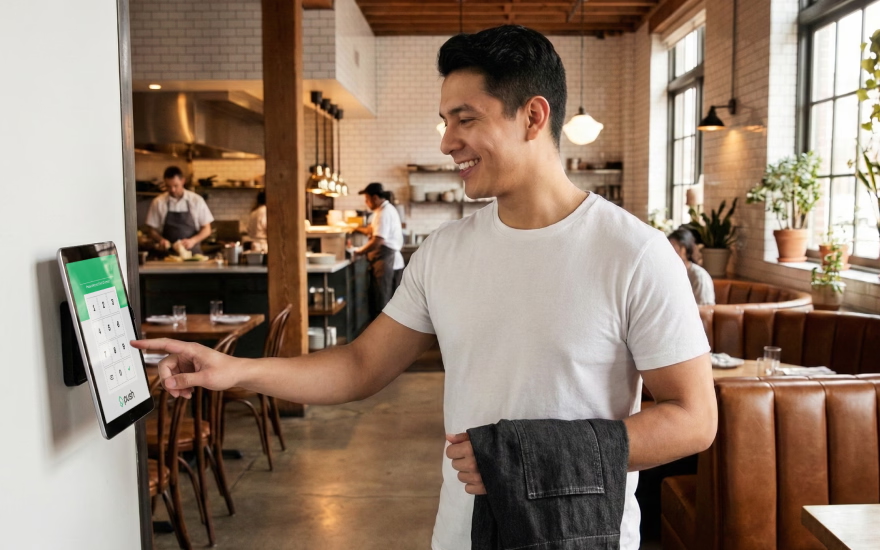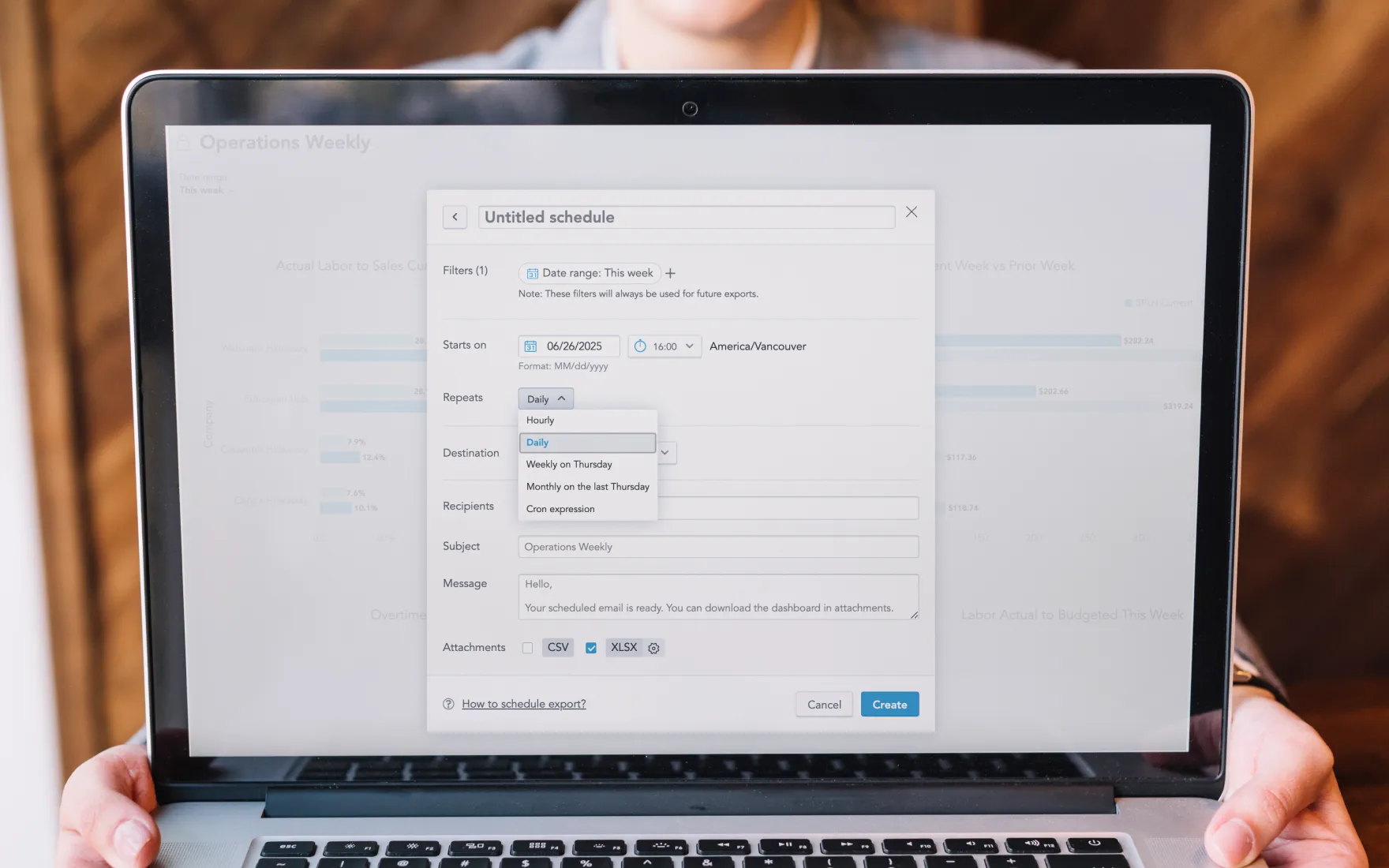A Restaurant POS Buyers Guide, For Beginners

Just like a realtor helps you navigate the ins and outs of what to look for while shopping for a home, this POS buyer’s guide provides expert insights into what to look for while comparing restaurant point of sale (POS) systems.
After all, a POS is one of the most important tech tools you’ll use in your restaurant. Why? Because it provides data about your business that you can use to increase revenue, save time and money (which is critical during a labor shortage), and improve the customer experience.
This POS system buyer’s guide equips you with everything you need to choose the best system for your business. Specifically, you’ll learn:
- What a restaurant POS is
- The benefits of restaurant point of sale systems
- What to look for when evaluating providers
- Bonus: Restaurant POS guide cheat sheet
What is a Restaurant POS (Point of Sale) System?
So, what does POS mean? A restaurant point of sale system is the central hub for all of your business transactions. It’s the hardware and software you use to run your restaurant, and where transactions between your business and its customers happen.
You can think of a point of sale system as a digital cash register that does so much more than just keep track of what customers bought. The best restaurant POS systems can also help with:
- Inventory management
- Table management
- Reports and analytics
- Menu management
- Staff management
- Tableside ordering
Additionally, POS systems integrate with tools you already have, like online ordering and reservations software, which help to extend their capabilities.
Top 3 benefits of a POS for restaurants.
A restaurant POS can help your business increase sales, deliver a great guest experience, and save time and money. Here’s how.
Increase sales.
This critical piece of restaurant technology comes equipped with features that drive revenue. A POS can:
- Enable your team to take more orders, more quickly with tableside ordering.
- Help you create the right promotions, at the right time, thanks to real-time data and analytics.
- Boost your average check size through upselling alerts for staff.
Deliver a great guest experience.
The hospitality industry is all about delighting customers. A POS system improves the guest experience by:
- Simplifying bill-splitting, so that customers can pay the tab however they’d like.
- Helping lines move faster at quick service restaurants with self-service ordering.
- Giving staff at full service restaurants more time with customers, thanks to tableside ordering capabilities.
Save time and money.
Efficiency is critical to running a financially viable business. Your POS saves your restaurant time and money by:
- Letting you review data and make changes to your menu from anywhere, at any time, in Cloud.
- Helping you reach the right business decisions, in less time, through reports. For example, a sales report can help you determine which dishes you should keep and ones dishes to remove from your menu.
- Streamlining staff management. Employees can clock in and out in a few taps, and managers can keep an eye on staff activity from anywhere.

Restaurant POS buyers guide.
Refer to this POS buyer’s guide while shopping for a new system to select the best tool for your business.
Consider your timeline.
How quickly do you need to get your POS up and running?
Some POS systems are ready to use right out of the box, while others involve a lengthy installation and training process. Find out how long it will take to get up and running with a new system and whether it will require any downtime for your restaurant.
Existing restaurants thinking about switching POS providers may require a quick transition so as to avoid service interruptions, while new restaurants may be able to take their time installing a new system ahead of opening day.
Evaluate your needs.
Different POS systems work better for different types of restaurants. Whether you’re a fine dining restaurant, quick-service restaurant, or coffee shop, the type of business you run will dictate the features you need, your hardware setup, and more.
For example, a full service restaurant with dozens of staff members may need a POS that has table management and tableside ordering capabilities, while a food truck may need a compact hardware setup and the ability to take payments without WiFi.
You should also consider things like ease of use and the type of hardware the system runs on. If you have a large team, you might want to get a system that uses user-friendly iPads instead of proprietary hardware because it will make the training process faster.
Know your budget.
Know what you can afford to pay for your new restaurant POS system, and make sure you understand all of the things you may need to pay for.
You can expect to pay one-time fees for hardware, onboarding, and installation. While the average cost for POS hardware is roughly $1,300, your costs can vary widely depending on how large your venue is and how many POS terminals you might need.
When it comes to ongoing expenses, you’ll pay monthly fees for software and payment processing. You can expect to pay $69 per month, on average, for POS software. Some providers also charge for support services, while others, like TouchBistro, offer free 24/7 support.
Determine your payment processing needs.
Not every POS system will integrate with every payment processor. Find out which processors work with the POS system you’re purchasing. If you choose a POS that does not support your current payments solution, then you’ll also have to shop for a new payment processor.
And, if you’re using a provider’s integrated payments solution, make sure you know whether you need to sign a multi-year contract, and how the fees are structured.
For instance, a fixed rate pricing model charges a percentage-based fee plus a fee per transaction, such as 2.9% plus $0.30 per transaction. This model would result in $3.20 in processing fees per $100 check.
On the other hand, there’s theWith a cost plus pricing model, which is generally considered to be the more popular and more transparent pricing model because of its easy-to-understand terms and fees. With cost plus pricing, you would pay an interchange fee, a basis point mark-up, and a transaction fee. You’ll likely encounter a 1.8% interchange fee, a 0.45% basis point mark-up, and a $0.15 transaction fee, resulting in $2.40 in processing fees on a $100 check.
Payment processing fees can add up, which is why it’s important to find a solution that integrates with your POS and offers the most equitable and transparent pricing.
Consider support services.
You may need to stop service at your restaurant if you encounter a glitch in your POS system or aren’t sure how to perform a critical function. However, time is money, so every second of downtime means lost profits. That’s why it’s important to consider the people behind the POS system you’re buying and understand what you can expect in terms of the quality and availability of support.
Buyers should also make a point of ensuring that their employees will be able to receive the training required to use the new system effectively. Look for a POS provider that offers detailed documentation, self-help guides, and video tutorials, as well as 24/7 support availability.
Think about your long-term goals and ROI.
Your POS system should not only support your current needs, but also your future goals. Consider your long-term business plan and make sure your POS will be able to scale with you.
Look for a system that makes it easy to add more terminals, integrates with your existing solutions, and offers other tools to help your business grow, like a loyalty program or digital gift cards.
A POS system is an investment in your business, and not just an expense. As with any other investment, you should receive a return on the money you put into it. Make sure that your POS streamlines and optimizes operations in a way that has a measurable impact on your restaurant’s bottom line. In other words, a POS system should pay for itself and add value in what it saves you in labor costs and what it helps you gain in sales.

POS buyer's guide cheat sheet.
Now that you know how to find the best PS system for your restaurant, here’s a restaurant POS guide evaluation cheat sheet you can use while comparing solutions.
Take a screenshot of the cheat sheet, copy and paste it into your notes app, or print it out and refer to it while you shop.
- Consider your timeline
- How quickly do I need to get my POS up and running?
- How long will this POS take to install and setup?
- How long will training take?
- Evaluate your needs
- What do I need my POS to be able to do?
- What unique characteristics does my business have that will impact my POS needs?
- Which type of hardware does the system I’m considering run on?
- Is this hardware easy to use?
- Create a budget
- How much can I afford to pay for my POS system, including one-time and ongoing fees?
- What does the system I’m considering charge for:
- Hardware?
- Installation?
- Training?
- Monthly software fees?
- Payment processing fees?
- Support services?
- Determine your payment processing needs
- Does the POS system I’m considering work with my current payment processing solution?
- If not, does it offer its own payment processor?
- If yes, will I need to sign a contract?
- Which fee model does this payment processor use?
- What can I expect to pay in processing fees with this system each month, based on my current credit card transactions?
- Consider support services
- Does this POS system charge for access to customer support?
- If so, how much?
- Is support available 24/7?
- What types of support does this provider offer?
- Think about your long-term goals and ROI
- How will this POS system grow with my business?
- What kind of add-on products does it offer to support my goals?
- What kind of integrations does this system offer?
- Will this POS system make a measurable impact on my bottom line?
Check out this POS buying guide for even more insights.
If you’re looking for a POS system that can help your business increase sales, improve the guest experience, and save time and money, look no further than TouchBistro POS.
Want to learn more about the restaurant industry from an industry expert at TouchBistro? Download the free webinar replay below!




